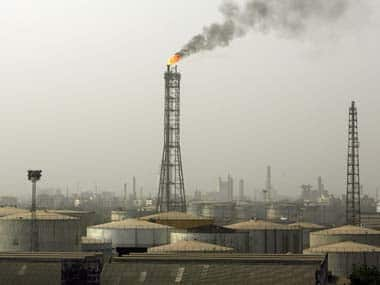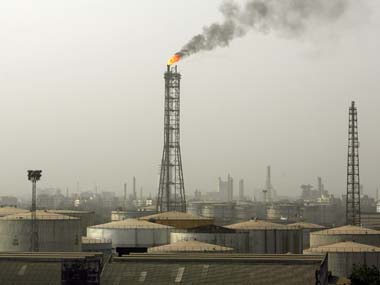Mystery solved, proclaimed Business Standard. The “mystery” had been flagged off by a rival business publication, The Economic Times, on 21 October when it published a report on the sudden surge in India’s exports to the Bahamas from $2.2 million in 2008-09 to $2.2 billion in 2010-11- a 1,000-fold increase in two years.
While reporting on this “ amazing surge, ”The Economic Times speculated that a lot of the exports may really be over-invoiced exports - which is one way of bringing back black money. “The number in no way matches the data on the Bahamas’ global imports, which, according to Unctad - the global trade and investments monitoring agency - was $2.8 billion in 2010,” said the newspaper.
[caption id=“attachment_115692” align=“alignleft” width=“380” caption=“India’s private sector oil refiners and state-controlled Mangalore Refinery and Petrochemicals Ltd are among the leading exporters of petroleum products. India’s total petroleum product exports went up from $29 billion in 2009-10 to $42.49 billion in 2010-11.Reuters.”]
 [/caption]
[/caption]
The Bahamas are better known as tax havens of the world - located south-east of the US state of Florida, and north of Cuba.
So how did Business Standard solve the mystery a day later? By putting some flesh on the export data. “The sharp increase (in exports to Bahamas) is mainly on account of petrol, whose share in total exports to the Bahamas was $777 million, or 88 per cent in 2009-10. The share remained the same in 2010-11, though the value of petrol exports went up to $1.92 billion. India did not export petrol to the Bahamas in 2008-09, which is what depressed its total exports to an insignificantly low level of $2.23 million that year.”
According to the newspaper, “India’s private sector oil refiners and state-controlled Mangalore Refinery and Petrochemicals Ltd are among the leading exporters of petroleum products. India’s total petroleum product exports went up from $29 billion in 2009-10 to $42.49 billion in 2010-11.”
Impact Shorts
More ShortsSo the answer, if one goes by the Business Standard explanation, is that India’s big private oil refiners - Reliance Industries and Essar Oil - were the big reasons why the Bahamas suddenly emerged as an export destination. But Essar has completely denied that it has made any exports to the Bahamas (this contradicts an earlier version of this report published on Monday). Says an official spokesman of Essar Oil: “Essar Oilmainly exports gasoline, fuel oil and small quantities of naphtha, with occasional cargoes of HSD (gasoil). These are made on freight on board (f.o.b.) basis. And most importantly, we categorically and on-record state that Essar Oil has not exported any cargo to the Bahamas.”
That leaves Reliance as the big exporter to the Bahamas. Why did it suddenly find the Bahamas such a lucrative place to export to?
The petrol export explanation still does not explain everything:
One, the 29-island Bahamas have an economy not larger than $8 billion and a population of only 3,50,000. Hence the probability of their importing so much petrol for themselves is unusual - to say the least. However, there is a strong possibility that the commodity was re-diverted from the high seas itself, even though the export numbers showed up on the Bahamas’ books. Even so, there is still a case for figuring out if these exports were for real.
Two, in 2010-11, Reliance reported a 36 percent rise in exports (in all its products and not just petrol). Mangalore Refinery & Petrochemicals (MRPL) reported a more modest export growth of 31.7 percent. We don’t know how much of the exports of the private refiner went to the Bahamas.
None of these growth figures square with the 1,000-fold rise in exports to (or through) the Bahamas - though this figure does include items other than petrol. What is undeniable is that an increasing share of petro-products demand was routed through the Bahamas - a tax haven.
Doubts over whether a significant chunk of India’s exports are for real surfaced after a recent Kotak Securities report red-flagged the huge discrepancy between official export figures and the figures put out by the 500 biggest listed companies in India, as represented by the BSE 500. Firstpost was the first to highlight the implications of the Kotak report.
The authors of the Kotak report - Sanjeev Prasad, Sunita Baldawa and Amit Kumar - concluded that there was enough ground for suspicion: “Our study of exports data of major engineering companies (including automobiles and metals) shows that the increase in their exports does not reconcile with the steep increase in official exports data. In fact, the gap is quite substantial.”
But there are enough skeptics around, and many business columnists have been reluctant to accept the implications of the Kotak report.
Swaminathan Aiyar is one skeptic. He wrote this in his Times of India column:
“Many people have jumped to the conclusion that the export boom represents over-invoiced exports to bring back black money….However, this theory has major weaknesses. When crooks under-invoiced exports in the past, the concealed sum was invisible to and untaxed by the government. But if crooks want to bring back this black money, it makes no sense to do so through over-invoiced exports - the inflated export value would be fully taxable.”
Actually, Aiyar is not be quite right. For two reasons. Over-invoiced exports make sense when the rest of the world is trying to trap tax evaders. Germany and the UK have, in fact, signed deals with Swiss banks to tax their nationals without disclosing their identity. If this is what our exporters feared would happen with India, they are right to bring in the money. Secondly, not all export revenues will be taxed. Companies with carryforward losses can set off these revenues against existing losses and can avoid or reduce taxation (of which more later).
Aiyar’s skepticism can thus be countered.
Ajit Ranade, Chief Economist at Aditya Birla Group, is another skeptic. His argument, which appeared in his column in the Mumbai Mirror, is that since half of India’s exports is accounted for by small and medium companies which are not represented in the BSE 500, the Kotak report is unlikely to be wholly true.
However, Ranade’s position is even less tenable than Aiyar’s because if exports grew very fast, and the big companies did not show that kind of export growth, the smaller companies would have accounted for an even larger proportion of exports than the big boys. Is this likely?
Take the Kotak report example. In metals and metal products, exports rose by 130 percent between 2009-10 and 2010-11 from $13 billion to $29 billion. But 22 big companies in the listed BSE 500 showed growth from $6.7 billion to $7.55 billion - a growth of around 12 percent, assuming an average notional exchange rate of Rs 45 to the dollar.
The rest of the small guys would thus have grown by nearly 240-250 percent (approximately) to bring total exports of metals and metal products to where it was in 2010-11.
Is it likely that small companies exported 20 times as fast as the big ones in a tough export climate?
Or is it more likely that most of the over-invoicing happened through smaller companies since the big companies could not have shown such a huge jump without adequate explanations?
It is more than probable that sharp jumps in exports are difficult to report in well-researched big companies, and hence the over-invoicing may have happened through the smaller companies. That is, if the Kotak thesis, is correct.
Quite clearly, the mystery of India’s export nirvana is not going to be so easily solved. There is a strong case for an investigation.
(Editor’s note: This is a corrected version of an earlier story which wrongly put Essar as an exporter to the Bahamas. We regret the error.)
)